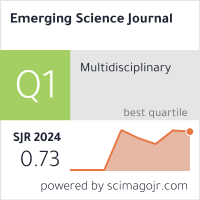Decoding User Intentions Towards AI Chatbot Services Under the Impact of Social Influences
Downloads
Artificial intelligence chatbot services (AICSs) have become more popular than ever in the current scenario despite much debate about their positives and negatives. This study aims to explore the links between social influences (SIs) related to community views, opinions, and the environment that affects individuals' transformation of their hedonic motivation (HM) and expectations (CEs), shedding light on their intention to continue using AICSs. Via a deductive approach and mixed methods, a cross-sectional study was conducted to evaluate the measurement and structural models with the participation of 332 university students in South Vietnam through an online survey (using Google Forms). Partial least squares structural equation modelling (PLS-SEM) was applied in this study. Research findings show that social influence (SIs) have positive impacts on HM, CEs (including performance and effort expectations), and behavioural intention toward AICS usage (BI). CEs and HM play intermediary roles in the relationship between SIs and BI. Notably, customer habit (HBT) has adverse moderating effects on relationships such as “SI and CEs” and “HM and BI,” clarifying customer experience about their intention to continue using AICSs in the current context. As a result, the research findings are expected to provide significant theoretical and practical implications for AI service managers and developers.
Downloads
[1] Kim, W., Ryoo, Y., & Choi, Y. K. (2024). That uncanny valley of mind: When anthropomorphic AI agents disrupt personalized advertising. International Journal of Advertising, 1–30. doi:10.1080/02650487.2024.2411669.
[2] Park, G., Chung, J., & Lee, S. (2023). Effect of AI-chatbot emotional disclosure on user satisfaction and reuse intention for mental health counseling: A serial mediation model. Current Psychology, 42(32), 28663–28673. doi:10.1007/s12144-022-03932-z.
[3] Zhang, D., & Zhao, X. (2024). Understanding adoption intention of virtual medical consultation systems: Perceptions of ChatGPT and satisfaction with doctors. Computers in Human Behavior, 159, 108359. doi:10.1016/j.chb.2024.108359.
[4] Qin, Y., Xu, Z., Wang, X., & Skare, M. (2024). Artificial intelligence and economic development: An evolutionary investigation and systematic review. Journal of the Knowledge Economy, 15(1), 1736–1770. doi:10.1007/s13132-023-01183-2.
[5] Butt, A. H., & Ahmad, H. (2023). AI-chatbot innovation—Leading toward consumer satisfaction, electronic word of mouth and continuous intention in online shopping. Journal of Telecommunications and the Digital Economy, 11(4), 156–184. doi:10.3316/informit.T2024030700010000236017032.
[6] Kim, J. S., Kim, M., & Baek, T. H. (2024). Enhancing user experience with a generative AI chatbot. International Journal of Human–Computer Interaction, 1–13. doi:10.1080/10447318.2024.2311971.
[7] Ding, Y., & Najaf, M. (2024). Interactivity, humanness, and trust: A psychological approach to AI-chatbot adoption in e-commerce. BMC Psychology, 12(1), 595. doi:10.1186/s40359-024-02083-z.
[8] Adjekum, D., Waller, Z., & Keller, J. (2024). An evaluation of artificial intelligence chatbots’ ethical use, attitudes towards technology, behavioral factors and student learning outcomes in collegiate aviation programs. The Collegiate Aviation Review International, 42(2). doi:10.0000/0002-7336-8696.
[9] Crawford, J., Allen, K.-A., Pani, B., & Cowling, M. (2024). When artificial intelligence substitutes humans in higher education: The cost of loneliness, student success, and retention. Studies in Higher Education, 49(5), 883–897. doi:10.1080/03075079.2024.2326956.
[10] Casheekar, A., Lahiri, A., Rath, K., Prabhakar, K. S., & Srinivasan, K. (2024). A contemporary review on chatbots, AI-powered virtual conversational agents, ChatGPT: Applications, open challenges and future research directions. Computer Science Review, 52, 100632. doi:10.1016/j.cosrev.2024.100632.
[11] Kushwaha, A. K., & Kar, A. K. (2024). MarkBot – a language model-driven chatbot for interactive marketing in the post-modern world. Information Systems Frontiers, 26(3), 857–874. doi:10.1007/s10796-021-10184-y.
[12] Huong, T. T. T., Hanh, N. T., Trang, H. T. D., & Chi, N. T. K. (2023). The impact of AI chatbots on customer experience in online retailing in an emerging economy. International Journal of Process Management and Benchmarking, 15(2), 182–197. doi:10.1504/IJPMB.2023.133154.
[13] Phan, Q. N., Tseng, C.‑C., Thi Hoai Le, T., & Nguyen, T. B. N. (2023). The application of chatbots on Vietnamese migrant workers’ rights protection in the implementation of new generation free trade agreements (FTAs). AI & Society, 38(4), 1771–1783. doi:10.1007/s00146-022-01416-z.
[14] Le, T. M. D., Do, H. T. N., Tran, K. M., Dang, V. T., & Nguyen, B. K. H. (2024). Integrating TAM and UGT to explore students’ motivation for using ChatGPT for learning in Vietnam. Journal of Research in Innovative Teaching & Learning. doi:10.1108/JRIT-05-2024-0116.
[15] Sofiyah, F. R., Dilham, A., Hutagalung, A. Q., Yulinda, Y., Lubis, A. S., & Marpaung, J. L. (2024). The chatbot artificial intelligence as the alternative customer services strategic to improve the customer relationship management in real-time responses. International Journal of Economics and Business Research, 27(5), 45–58. doi:10.1504/IJEBR.2024.139810.
[16] Wei, X., Chu, X., Geng, J., Wang, Y., Wang, P., Wang, H., Wang, C., & Lei, L. (2024). Societal impacts of chatbots and mitigation strategies for negative impacts: A large-scale qualitative survey of ChatGPT users. Technology in Society, 77, 102566. doi:10.1016/j.techsoc.2024.102566.
[17] Camilleri, M. A. (2024). Factors affecting performance expectancy and intentions to use ChatGPT: Using SmartPLS to advance an information technology acceptance framework. Technological Forecasting and Social Change, 201, 123247. doi:10.1016/j.techfore.2024.123247.
[18] Chen, G., Fan, J., & Azam, M. (2024). Exploring artificial intelligence (AI) chatbot adoption among research scholars using the unified theory of acceptance and use of technology (UTAUT). Journal of Librarianship and Information Science, 1–19. doi:10.1177/09610006241269189.
[19] Liu, M., Yang, Y., Ren, Y., Jia, Y., Ma, H., Luo, J., Fang, S., Qi, M., & Zhang, L. (2024). What influences consumer AI chatbot use intention? An application of the extended technology acceptance model. Journal of Hospitality and Tourism Technology, 15(4), 667–689. doi:10.1108/JHTT-03-2023-0057.
[20] Park, Y., Kim, J., Jiang, Q., & Kim, K. H. (2024). Impact of artificial intelligence (AI) chatbot characteristics on customer experience and customer satisfaction. Journal of Global Scholars of Marketing Science, 34(3), 439–457. doi:10.1080/21639159.2024.2362654.
[21] Al‑Adwan, A. S., Jafar, R. M. S., & Sitar‑Tăut, D.‑A. (2024). Breaking into the black box of consumers’ perceptions on metaverse commerce: An integrated model of UTAUT 2 and dual‑factor theory. Asia Pacific Management Review. doi:10.1016/j.apmrv.2024.09.004.
[22] Tian, W., Ge, J., Zhao, Y., & Zheng, X. (2024). AI chatbots in Chinese higher education: Adoption, perception, and influence among graduate students—An integrated analysis utilizing UTAUT and ECM models. Frontiers in Psychology, 15, 1268549. doi:10.3389/fpsyg.2024.1268549.
[23] Tram, N. H. M. (2024). Unveiling the drivers of AI integration among language teachers: Integrating UTAUT and AI‑TPACK. Computers in the Schools, 1–21. doi:10.1080/07380569.2024.2441155.
[24] Pop, R.‑A., Săplăcan, Z., & Alt, M.‑A. (2020). Social media goes green—The impact of social media on green cosmetics purchase motivation and intention. Information, 11(9), Article 447. doi:10.3390/info11090447.
[25] Xie, Y., Liang, C., Zhou, P., & Jiang, L. (2024). Exploring the influence mechanism of chatbot‑expressed humor on service satisfaction in online customer service. Journal of Retailing and Consumer Services, 76, 103599. doi:10.1016/j.jretconser.2023.103599.
[26] Liu, G., & Ma, C. (2024). Measuring EFL learners’ use of ChatGPT in informal digital learning of English based on the technology acceptance model. Innovation in Language Learning and Teaching, 18(2), 125–138. doi:10.1080/17501229.2023.2240316.
[27] Orden‑Mejía, M., Carvache‑Franco, M., Huertas, A., Carvache‑Franco, O., & Carvache‑Franco, W. (2024). The role of AI‑based destination chatbots in satisfaction, continued usage intention, and visit intention: A study from Quito, Ecuador. International Journal of Human–Computer Interaction, 1–16. doi:10.1080/10447318.2024.2425882.
[28] Esiyok, E., Gokcearslan, S., & Kucukergin, K. G. (2024). Acceptance of educational use of AI chatbots in the context of self‑directed learning with technology and ICT self‑efficacy of undergraduate students. International Journal of Human–Computer Interaction, 1–10. doi:10.1080/10447318.2024.2303557.
[29] Miraz, M. H., Ya’u, A., Adeyinka‑Ojo, S., Sarkar, J. B., Hasan, M. T., Hoque, K., & Jin, H. H. (2024). Intention‑to‑use determinants of AI chatbots to improve customer relationship management efficiency. Cogent Business & Management, 11(1), Article 2411445. doi:10.1080/23311975.2024.2411445.
[30] Kleine, A.‑K., Schaffernak, I., & Lermer, E. (2025). Exploring predictors of AI chatbot usage intensity among students: Within‑ and between‑person relationships based on the technology acceptance model. Computers in Human Behavior: Artificial Humans, 3, 100113. doi:10.1016/j.chbah.2024.100113.
[31] Jo, H. (2024). From concerns to benefits: A comprehensive study of ChatGPT usage in education. International Journal of Educational Technology in Higher Education, 21(1), 35. doi:10.1186/s41239-024-00471-4.
[32] Zhao, H., & Min, Q. (2024). Exploring continued usage of an AI teaching assistant among university students: A temporal distance perspective. Information & Management, 61(6), 104012. doi:10.1016/j.im.2024.104012.
[33] Soodan, V., Rana, A., Jain, A., & Sharma, D. (2024). AI chatbot adoption in academia: Task fit, usefulness and collegial ties. Journal of Information Technology Education. Innovations in Practice, 23, Article 1. doi:10.28945/5260.
[34] Yue, Y., Ng, S. I., & Basha, N. K. (2024). Consumption values, attitudes and continuance intention to adopt ChatGPT-driven e-Commerce AI Chatbot (LazzieChat). Pakistan Journal of Commerce and Social Sciences (PJCSS), 18(2), 249-284.
[35] Liu, W., Jiang, M., Li, W., & Mou, J. (2024). How does the anthropomorphism of AI chatbots facilitate users’ reuse intention in online health consultation services? The moderating role of disease severity. Technological Forecasting and Social Change, 203, 123407. doi:10.1016/j.techfore.2024.123407.
[36] Youn, K., & Cho, M. (2023). Business types matter: New insights into the effects of anthropomorphic cues in AI chatbots. Journal of Services Marketing, 37(8), 1032–1045. doi:10.1108/JSM-04-2022-0126.
[37] Sundjaja, A. M., Utomo, P., & Colline, F. (2025). The determinant factors of continuance use of customer service chatbots in Indonesian e-commerce: Extended expectation confirmation theory. Journal of Science and Technology Policy Management, 16(1), 182–203. doi:10.1108/JSTPM-04-2024-0137.
[38] Mehrabian, A. (1974). An approach to environmental psychology. MIT Press, Massachusetts, United States.
[39] Venkatesh, V., Thong, J. Y. L., & Xu, X. (2012). Consumer acceptance and use of information technology: Extending the unified theory of acceptance and use of technology. MIS Quarterly, 36(1), 157–178. doi:10.2307/41410412.
[40] Fleetwood, S. (2021). A definition of habit for socio-economics. Review of Social Economy, 79(2), 131–165. doi:10.1080/00346764.2019.1630668.
[41] Duc, T. T., Van, P. T., Thi, N. P. C., Tan, L. L., & Thi, L. N. N. (2024). A case study of decision‑making towards using online food distribution services after COVID‑19 in Vietnam. Distribution Science Research, 22(3), 33–47. doi:10.15722/jds.22.03.202403.33.
[42] Nguyen, T. L., Tran, T. A. P., Duc Tam, L., & Van Pham, T. (2024). Enterprise innovation in the distribution sector such as logistics and trade towards green and sustainable development. Journal of Distribution Science, 22(10), 1–12. doi:10.15722/jds.22.10.202410.1.
[43] Rafiq, F., Dogra, N., Adil, M., & Wu, J.-Z. (2022). Examining consumers’ intention to adopt AI-chatbots in tourism using partial least squares structural equation modeling. Mathematics, 10(13), 2190. doi:10.3390/math10132190.
[44] Tran, T. A. P., & Hou, X. (2024). Enterprise innovation decision‑making towards green and sustainability from the perspective of cognitive innovation. Emerging Science Journal, 8(6), 2360–2372. doi:10.28991/ESJ-2024-08-06-013.
[45] Lu, Y., & Zhang, J. (2025). Balancing identity diversity and product contexts: Understanding consumer trust in AI‑enhanced chatbot services. Journal of Retailing and Consumer Services, 84, 104205. doi:10.1016/j.jretconser.2024.104205.
[46] Al‑Qaysi, N., Al‑Emran, M., Al‑Sharafi, M. A., Iranmanesh, M., Ahmad, A., & Mahmoud, M. A. (2024). Determinants of ChatGPT use and its impact on learning performance: An integrated model of BRT and TPB. International Journal of Human–Computer Interaction, 1–13. doi:10.1080/10447318.2024.2361210.
[47] Park, D. Y., & Kim, H. (2023). Determinants of intentions to use digital mental healthcare content among university students, faculty, and staff: Motivation, perceived usefulness, perceived ease of use, and parasocial interaction with AI chatbot. Sustainability, 15(1), 872. doi:10.3390/su15010872.
[48] Lai, C. Y., Cheung, K. Y., Chan, C. S., & Law, K. K. (2024). Integrating the adapted UTAUT model with moral obligation, trust and perceived risk to predict ChatGPT adoption for assessment support: A survey with students. Computers and Education: Artificial Intelligence, 6, 100246. doi:10.1016/j.caeai.2024.100246.
[49] Tanantong, T., & Wongras, P. (2024). A UTAUT-based framework for analyzing users’ intention to adopt artificial intelligence in human resource recruitment: A case study of Thailand. Systems, 12(1), 28. doi:10.3390/systems12010028.
[50] Acosta‑Enriquez, B. G., Farroñan, E. V. R., Zapata, L. I. V., Garcia, F. S. M., Rabanal‑León, H. C., Angaspilco, J. E. M., & Bocanegra, J. C. S. (2024). Acceptance of artificial intelligence in university contexts: A conceptual analysis based on UTAUT2 theory. Heliyon, 10(19), Article e38315. doi:10.1016/j.heliyon.2024.e38315.
[51] Wijaya, T. T., Su, M., Cao, Y., Weinhandl, R., & Houghton, T. (2024). Examining Chinese preservice mathematics teachers’ adoption of AI chatbots for learning: Unpacking perspectives through the UTAUT2 model. Education and Information Technologies, 1–29. doi:10.1007/s10639-024-12837-2.
[52] Tran, T. D., Doan, H. T., Van Pham, T., & Truong, T. M. T. (2024). Social influences, cognitive competence, problem‑solving skills: A case study of problem‑solving skills in the context of digitalization adoption. International Journal of Instruction, 17(4), 195–218. doi:10.29333/iji.2024.17412a.
[53] Sarker, R., Currie, G., & Reynolds, J. (2025). The pandemic is over but riders still fear infection – An extended behavioural model explaining post‑pandemic transit avoidance related to perceived infection fear. Transportation Research Part A: Policy and Practice, 192, 104363. doi:10.1016/j.tra.2024.104363.
[54] Sitar‑Tăut, D. A. (2021). Mobile learning acceptance in social distancing during the COVID‑19 outbreak: The mediation effect of hedonic motivation. Human Behavior and Emerging Technologies, 3(3), 366–378. doi:10.1002/hbe2.261.
[55] Kumar, A., & Pandey, M. (2023). Social media and impact of altruistic motivation, egoistic motivation, subjective norms, and eWOM toward green consumption behavior: An empirical investigation. Sustainability, 15(5), 4222. doi:10.3390/su15054222.
[56] Lorenz, G., Boda, Z., Salikutluk, Z., & Jansen, M. (2020). Social influence or selection? Peer effects on the development of adolescents’ educational expectations in Germany. British Journal of Sociology of Education, 41(5), 643–669. doi:10.1080/01425692.2020.1763163.
[57] Lasselle, L., & Smith, I. (2024). Expectations of progression to university among pupils in rural communities: The role of social influences. Oxford Review of Education, 1–21. doi:10.1080/03054985.2023.2293185.
[58] Paraskevi, G., Saprikis, V., & Avlogiaris, G. (2023). Modeling nonusers’ behavioural intention towards mobile chatbot adoption: An extension of the UTAUT2 model with mobile service quality determinants. Human Behavior and Emerging Technologies, 2023(1), Article 8859989. doi:10.1155/2023/8859989.
[59] García de Blanes Sebastián, M., Sarmiento Guede, J. R., & Antonovica, A. (2022). Application and extension of the UTAUT2 model for determining behavioural intention factors in use of the artificial intelligence virtual assistants. Frontiers in Psychology, 13, 993935. doi:10.3389/fpsyg.2022.993935.
[60] Chiu, C.‑M., Hsu, M.‑H., Lai, H., & Chang, C.‑M. (2012). Re‑examining the influence of trust on online repeat purchase intention: The moderating role of habit and its antecedents. Decision Support Systems, 53(4), 835–845. doi:10.1016/j.dss.2012.05.021.
[61] Paul, T. J., & Jacob, J. (2017). Information system continuance usage: Moderating role of habit. International Journal of Business Information Systems, 26(2), 166–184. doi:10.1504/IJBIS.2017.086328.
[62] Sharifi Fard, S., Alkelani, A. M., & Tamam, E. (2019). Habit as a moderator of the association of utilitarian motivation and hedonic motivation with purchase intention: Implications for social networking websites. Cogent Social Sciences, 5(1), 1674068. doi:10.1080/23311886.2019.1674068.
[63] Iranmanesh, M., Min, C. L., Senali, M. G., Nikbin, D., & Foroughi, B. (2022). Determinants of switching intention from web-based stores to retail apps: Habit as a moderator. Journal of Retailing and Consumer Services, 66, 102957. doi:10.1016/j.jretconser.2022.102957.
[64] Hair, J. F. Jr., Hult, G. T. M., Ringle, C. M., Sarstedt, M., Danks, N. P., & Ray, S. (2021). Partial least squares structural equation modeling (PLS‑SEM) using R: A workbook. Springer Nature, Cham, Switzerland. doi:10.1007/978-3-030-80519-7.
[65] Cristobal, E., Flavian, C., & Guinaliu, M. (2007). Perceived e‑service quality (PeSQ): Measurement validation and effects on consumer satisfaction and website loyalty. Managing Service Quality: An International Journal, 17(3), 317–340. doi:10.1108/09604520710744326.
[66] Fornell, C. (1981). Structural equation models with unobservable variables and measurement error: Algebra and statistics. Journal of Marketing Research, 18(3), 328–336. doi:10.1177/002224378101800313.
[67] Biloš, A., & Budimir, B. (2024). Understanding the adoption dynamics of ChatGPT among Generation Z: Insights from a modified UTAUT2 model. Journal of Theoretical and Applied Electronic Commerce Research, 19(2), 863–879. doi:10.3390/jtaer19020045.
[68] Xu, S., Chen, P., & Zhang, G. (2024). Exploring Chinese university educators’ acceptance and intention to use AI tools: An application of the UTAUT2 model. SAGE Open, 14(4). doi:10.1177/21582440241290013.
[69] Arbulú Ballesteros, M. A., Acosta Enríquez, B. G., Ramos Farroñán, E. V., García Juárez, H. D., Cruz Salinas, L. E., Blas Sánchez, J. E., Arbulú Castillo, J. C., Licapa-Redolfo, G. S., & Farfán Chilicaus, G. C. (2024). The sustainable integration of AI in higher education: Analyzing ChatGPT acceptance factors through an extended UTAUT2 framework in Peruvian universities. Sustainability, 16(23), 10707. doi:10.3390/su162310707.
[70] Liu, N., Deng, W., & Ayub, A. F. M. (2025). Exploring the adoption of AI-enabled English learning applications among university students using an extended UTAUT2 model. Education and Information Technologies, 1–33. doi:10.1007/s10639-025-13349-3.
- This work (including HTML and PDF Files) is licensed under a Creative Commons Attribution 4.0 International License.




















